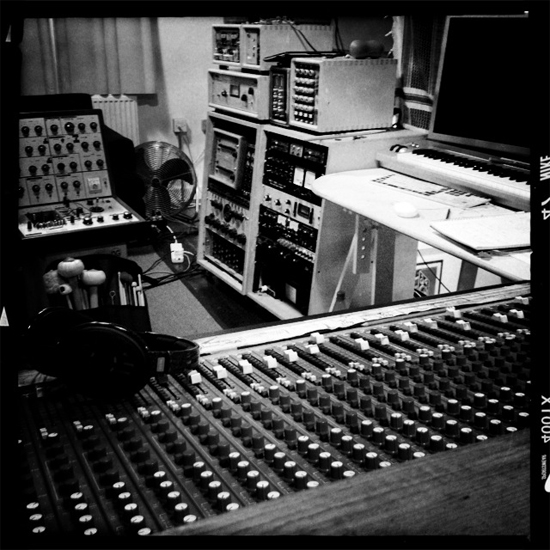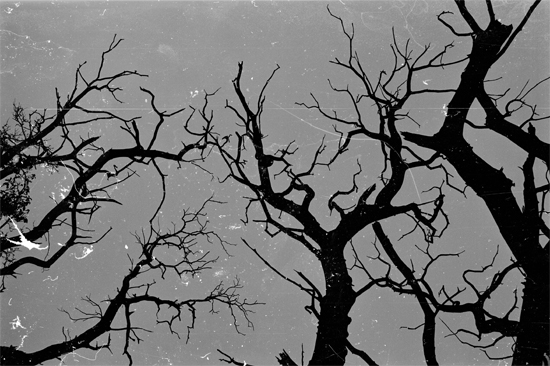The last time I spoke to Adrian Utley for the Quietus, back in our very earliest days, it was to discuss his love of camper vans and the great outdoors. Four-and-a-bit years later, and Utley is taking a break from Portishead’s recent excellent run of tour dates to apply his musical skills to the countryside that he loves by partnering up to compose a Sonic Journey. Commissioned by sounduk, these have previously seen Shackleton and Vengeance Tenfold teaming up for a meditation for the railway line along the sea front at Dawlish (read the Quietus feature here), and Micachu’s rumination on the walkways of the Barbican.
Utley’s Sonic Journey is written to accompany a stroll around the ancient trees at National Trust property, Croft Castle in Herefordshire. As well as the 15 minutes of music to go with the walk, Utley’s friend and collaboration John Minton has created a film of still shots of the trees so you can undertake the walk in Bognor, Boston or Barry, which can be viewed over at the space The Space.
Utley’s soundtrack – spacious, contempletative – seems in parts influenced by much of the early music that he’s currently listening to (during our interview he recommends Carlo Gesualdo, "a total cunt from the 16th century"), with deftly plucked guitar starting and finishing things off. There’s also thoughtful synthesisers, drones, and gentle, quiet whisper. The beauty of Utley’s journey is that it works as an evocative piece of music whether you’re amidst the ancient gnarled trunks and spidery branches or not. Even sat here at my desk amidst the knackered grey office buildings and run-down terraces of Seven Sisters, North East London, the music transports to the presence of the ancient trees, the biosystems they support, and endurance beyond a human lifetime.
So Adrian, as we know you’re a big fan of the outdoors…
Adrian Utley: I do spend a lot of time walking, I have done all my life, especially in wild places. I’ve recently come back from the North West of Scotland, which is very remote, and I walk in Dartmoor a lot, and I walk in cities. For me it’s a calm space, even if you’re in New York. You can walk for hours and it’s quite calm even though it’s mad around you. When I walk I don’t really listen to music, it’s the last thing I want to do. But I thought that this was interesting. The walk I did was just 15 minutes through these ancient trees, 400 years old, one of them is 1000 years old, which puts you firmly in King Harold’s time. It’s called Sonic Journey, and I think it’s more about an audio experience, an emotional experience within this landscape. I decided to make it a meditative thing, which is what walking is for me.
Walking creates a narrative from the rhythm, and that rhythm sends you into a trance.
AU: It is a kind of trance. When I walk I walk for at least four or five hours, and from the hectic lifestyles that a lot of us have, it is a meditative state, through rhythm or through just a kind of meditation, a clearing out of your mind, or a really intense thinking period. It’s good for me to work things out by walking. When I went there the second time and didn’t go with or tell anyone I was going, I was just in my own space and walked around… the trees are just astonishing-looking. There’s a chestnut avenue… it’s in no way energetic, this walk, you just wander along and observe this stuff that’s around, you these amazing old trees. I went for a walk with the National Trust tree expert, Brian [Muelaner], a fantastic guy, and he told me that he doesn’t believe this, but the myth is that these trees were grown from chestnuts that they found on the Spanish Armada ships. It’s a good story. Opposite it are loads of oaks, so there are the English and there are the Spanish. I love that story even if it’s not true.
They made this avenue of trees, and now 400 years later they’re so weird and twisted, fantastic looking things, they’re compelling in their beauty, their strangeness, they’re really powerful. It’s not like looking at the landscape around you, you’re kind of in this world with these trees.

How did the music itself take shape?
AU: I started off with this very meditative thing, using lots of singing bowls, they’re a good starting point. John Minton’s film is based on my feelings of what I felt when I was there. The strange, surreal, almost sculptural nature of the trees. I’d suggest walking at twilight where there’s that calmer energy and the landscape gets itself back from the public. When you’re walking you get that odd feeling when it feels that the light is going to run out…
It must trigger something very primal, pre-modern instinct, the moment when the difference between night and day becomes more real.
AU: Yeah that’s exactly put what I was trying to say. My music reflected that, in a way. It’s become a bit old school Radiophonic. I used the old VCS3 synthesiser, and recorded tones of notes onto my computer, and put every note through a different channel on my mixing desk. Then I could play the faders so you can play music with a pre-determined tonality and an interrupted sound that comes in and out. It’s basically just pure sidetones, very pure. Then I made wind sounds, not progtastic Hawkwindesque wind, I tried to make it as natural as possible, done on an old synthesiser from the 60s. Then there’s some guitar, and some microphone feedback. I did this gig with Aphex Twin in Poland and we were playing some Steve Reich stuff. He did this piece called Pendulum, which is microphones swinging over speakers. I’ve always loved controlled feedback, so I started with some of these ideas. I ended up finding a microphone and amplifier and a bit of space, and moving the microphone around so I could get different tones. One of the sections is that, a very simple way of producing stuff.

Were you tempted to use any field recordings, or did you want to focuss on responding to it?
AU: I did use a bit of wood that I had picked up from one of those trees on a walk to play my guitar with, you can hear that in the background. I thought about banging sticks together, or hitting a tree with a piece of wood and recording it, but I didn’t do that in the end.
I suppose if you’re doing the walk, and have the headphones quiet enough, you’ll be able to hear the ambient sounds.
AU: It’s interesting you say that, because when I took my experimental pieces up to the walk last week just before I finally put it together I hadn’t recorded the mp3s loud enough to really crank them, and my iPod wouldn’t go any louder, and I could hear the water in the stream you have to cross, and I thought that was really nice. So you have that option if you turn it down, or have one ear half off. These are all options you can do.
It’s different for every person who does the walk.
AU: It’s a John Cage thing, isn’t it? Every one is different. And also people will walk at different speeds, I have a map and I know where this or that starts, but somebody might take the whole walk to go past the first tree. I can write it down but it’s up to people to do it at their own speed.
We in Britain seem to have a special thing for trees. The petition to stop them being sold off was really big deal and actually succeeded.
I think you’re right. They give us our oxygen for a start. There’s something calming about trees, even though they can be frightening at times.
Like when it’s getting dark? They do have personalities, without sounding like someone who talks to them.
You’re on the edge of that all the time. I agree with you, I think they do. And these trees are fantastic characters, each one has mutated. They’ve wiggled out of the line they were originally in, the branches are all falling down, there’s debris on the ground, some of them are dead. It’s amazingly sculptural, and I think that in the winter, when there are no leaves to get in the way, the look of it is going to be amazing. There’s a close thing between humans and trees.
In theory someone could rip the mp3, and 500 years be wandering around the same trees, or their immediate descendants…
AU: That would be good wouldn’t it? They’ll be calling it ‘hey nonny’ music.
For more information on Adrian’s Sonic Journey, visit the sounduk website



